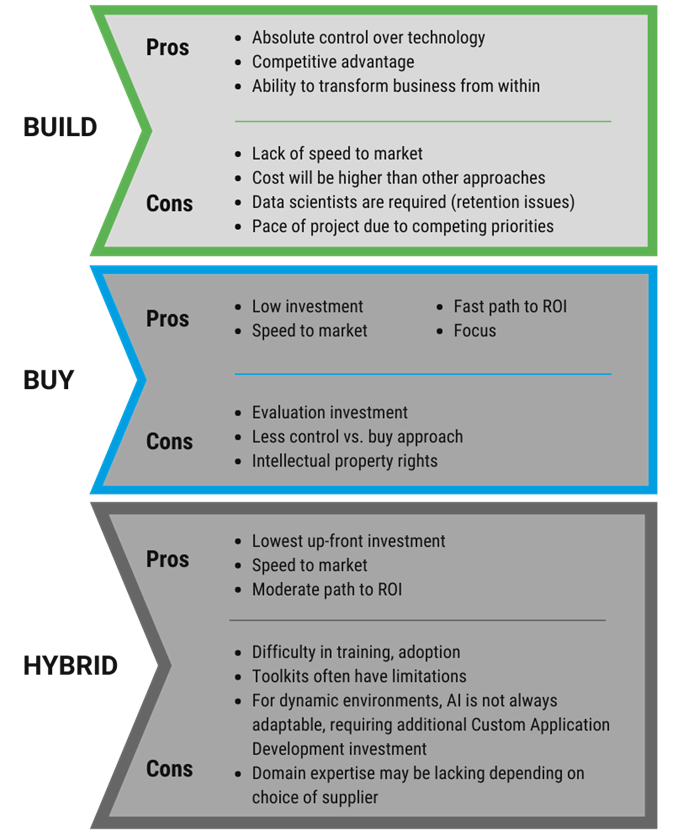Choosing the Right AI approach for your business
Companies often kiss more frogs than princes when it comes to artificial intelligence investments.
Much has changed this year. The new normal brought about by the COVID-19 pandemic has affected everyone and everything. Globally, companies have been forced into crisis management mode: adapting, retooling and training employees to work remotely while adopting new technologies to stay productive. So, is AI good or bad?
During all of this, corporate CEOs are trying to accomplish three primary objectives for their business: maximize growth, minimize risk, and protect margins. These are daunting goals.
They have become even more challenging in manufacturing, considering the new work rules, the changing corporate remote work policies, and the use of conventional manufacturing technologies. Confused, many of us are working hard just to keep up with the latest buzzwords accompanying digital transformations.
The adoption of artificial intelligence in the manufacturing industry is one of them. We’ve become familiar with terms like Industry 4.0, SMART Factories, IIoT, Artificial Intelligence, Machine Learning and Predictive Analytics. We hear these terms every day; they have important definitions, even if understood differently based on roles within an organization.
The Race to Reimagine Business
This new work environment has accelerated investment in new technologies and the adoption of those technologies required to keep pace with digitally-driven businesses.
Companies looking to scale their operations are adopting new technologies at warp speed to keep pace with their competition, adapt to the aging workforce, and accomplish more with less.
There is an unending list of artificial intelligence firms to choose from in today’s marketplace, many with steep price tags based on the objectives businesses are looking to accomplish.
With loads of venture capital and private equity funds all looking to place bets on AI, there are plenty of savvy marketers who can raise funds with a few good ideas and a polished pitch deck.
IBM’s Watson platform is impressively powerful but comes with a price tag often out of reach for small and medium-sized enterprises. Startups are plentiful, but it’s a buyer-beware market due to the fast, easy access to growth capital.
It’s imperative to separate the chaff from the wheat, the frogs from the princes.
Below are some factors to consider as you embark upon your journey to transform your company’s business digitally.
Most corporate investments take the form of the following approaches.
- Build: Source and develop an internal technology solution.
- Buy: Hire a turnkey platform that delivers continuous improvement.
- Hybrid: Rent a toolkit solution with off-the-shelf AI that requires domain expertise and implementation assistance.
Some obvious pros and cons come with all the three approaches:

Artificial Intelligence for Your Business: Rules to Follow
Rule # 1 – CAREFUL PLANNING
Decide which of the three approaches will best suit your business needs and your company culture. The pros and cons of each approach will be different for each company and will often be dictated by the level of senior management sponsorship and your budget.
Building requires an understanding that you are making a very long-term commitment and one that will likely lose luster over time as technology continues to improve and advance over time.
- Understand your company requirements in detail up-front: What problem are you looking to solve? What pain points in your business can AI solve? Be sure to understand whether the technology you are looking to invest in requires you to work from a toolkit or if they offer a turnkey solution more easily implemented and adopted.
- A turnkey platform is your best chance for rapid adoption, scale and path to measurable ROI. Unfortunately, toolkits often shift the burden of building out the solution onto a company’s internal IT team and may require extensive training.
- Technology challenging to adopt and scale can be detrimental and operationally intrusive to your enterprise. The tool kit approach may present challenges in terms of interoperability with existing equipment, architecture and legacy tech investments. A deep understanding of software configuration and deployment skill sets will most likely be required.
Rule #2 – RIGOROUS DUE DILIGENCE
Make sure you are working with a company that has applied intelligence operational inside its technology offering.
If you cannot witness it visually or get empirical proof that it will achieve your company’s business objectives, then have your IT group perform an in-depth due diligence audit of their capabilities and features.
- Many firms tend to have expensive data scientists on staff with talents for scientific theory, data model building, and may even be able to deliver useful off-line analyses and algorithm building.
- Unless the data science team understands how the algorithms’ practical application gets deployed into the code base, you often end up with nothing more than data science projects.
- If you aren’t 100% certain the science is being applied in production, you need to understand why. Often, the data science team and the software development team cannot work together to deploy code that applies the science inside the technology solution.
- At best, you will end up with a BI monitoring solution and nothing better. This is where most AI firms fail, and you need to ensure you don’t fall into this trap because you can wait for an eternity and still never see the light of day. If the firm you are considering is only focused on monitoring, root cause analysis, and prediction, those are essential system capabilities, but firms delivering recommendation and autonomous manufacturing should warrant deeper consideration. It’s the classic case of reactive control vs. proactive control of manufacturing parameter settings and outcomes. More about Why 85% of Machine Learning Projects Fail and how to avoid this.
- It’s essential to understand the credentials of the data science team. Are they experienced? Do they have good leadership? What’s the average tenure of a data scientist with the firm? Not all data scientists are created equal; there are good practitioners and bad practitioners, and if the leader of the team just got their Ph.D. but has no real practical business experience, you should run away.
Rule # 3 – ONE SIZE DOES NOT FIT ALL
I’ve witnessed many AI firms make bold claims about their machine learning capabilities on their websites and in their marketing collateral. They are often skilled at doing software demonstrations that “wow an audience.”
AI buyers can easily get drunk on a flashy software demonstration delivered by a skilled salesperson.
In today’s world of a thousand choices, it pays to do in-depth due diligence and check references carefully.
Predictive analytics is all the rage as the benefits of accurately predicting what could happen, what might happen, and how to avoid problems and take advantage of trends can be highly valuable to any business.
However, in my experience, I’ve witnessed many firms lay claim to their predictive capabilities only to witness their early adopters become disillusioned as they patiently wait years to witness predictions with any level of accuracy or value.
The last thing you want to be known for is the person who advocated for an AI firm’s technology, even going so far as to make a six or seven-figure investment in technology only to find out the platform couldn’t predict rain in a hurricane.
Therefore, below is a list of best practices I suggest buyers adopt before investing in an AI firm’s technology for business.
Best Practices for Investing in Artificial Intelligence
- Get good advice: check your references carefully. Ask to talk with a customer who has experience working with the firm and ask them whether or not they’ve invested in some future outcome or if the applied AI is actually solving a problem, delivering sound predictions, and providing measurable value back to their business.
- Look for domain experience: all business value propositions vary. If the firm you are thinking about hiring doesn’t have resident domain experience, calculate that into your investment. It takes patience to be the company delivering the domain experience if it isn’t resident within the firm you are hiring.
- Avoid pilot purgatory: If you agree to a pilot to prove the value of the AI solution, make sure you hold that firm to minimum viable product (MVP) criteria and a strict timeline for that firm to prove its efficacy work.
- It’s imperative to agree on success criteria before the pilot and wise to not make massive six and seven-figure investments in what can amount to science experiments.
- Pilots have a way of dragging on far longer than anybody anticipated for a myriad of reasons, some of which may be legitimate. Still, at some point, it’s wise to throw the towel in and move on if the pilot feels like it will drag on forever.
- The best way to avoid pilot purgatory is to draw up a project plan and hold that AI company to the timeline.
- Pros and cons of “bootstrapped” vs. “capitalized” startups: if you are considering hiring a startup, there are distinct advantages, particularly if you are willing to take on some risk as an early adopter of their technology.
- Make sure to research whether or not they have sufficient cash-flow and ensure they will be solvent for at least the next 3-5 years. If the co-founders are all pulling up to the office in Seven Series BMWs, run-away… they are spending their growth capital on car payments.
- Bootstrapped companies drive Hondas and Toyotas and have more skin in the game and a stronger incentive to succeed than funded co-founders looking to make a quick buck, whether it’s off the back of early investors, the clients, or a quick exit. Make sure your business interests are protected in the event of a change in control.
Author
Tom Tulloch is Chief Commercial Officer at ProcessMiner. This artificial intelligence turnkey platform predicts, in real-time, the quality of a product during the manufacturing process and makes corrective-action recommendations on that quality, and then autonomously applies those recommendations.



